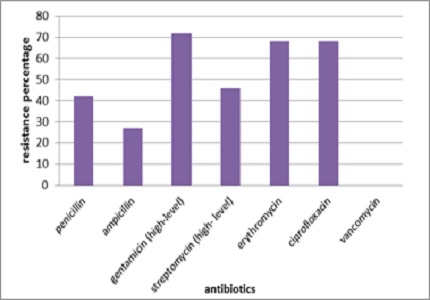Bactericidal activity of acetone extract of Alpinia galanga on multidrug resistant clinical isolates of Enterococcus faecalis
Abstract
Introduction: The objective of the study was to evaluate the inhibitory activity of five traditional Indian medicinal herbs against multidrug resistant clinical isolates of E. faecalis.
Methods: Sixty five E. faecalisderived from clinical specimens were tested for their resistance pattern to 7 antibiotics by disc diffusion method. Extracts from 5 medicinal plant parts were obtained and tested for inhibitory activity against multi drug resistant clinical E. faecalisisolates. The minimum bactericidal concentration (MBC) for the active plant extract exhibiting highest activity towards the susceptible isolateswas determined by macro broth dilution method followed by sub culturing on agar plate.
Results: All the clinically derived E. faecalis isolates were resistant to two or more antibiotics. Acetone extract of Alpiniagalanga inhibited 67.69% of E. faecalis and concentration of <5.0mg/ml was found to exert bactericidal activity against multi drug resistant isolates.
Conclusion: Acetone extract of A. galanga exhibit bactericidal activity against multi-drug resistant clinical isolates of E. faecalis and hence could be potential phytotherapeutic candidate.
Downloads
References
2. Kumar S, Gupta P, Sharma S, Kumar D. A review on immunostimulatory plants. Journal of Chinese Integrative Medicine. 2011 Feb;9(2):117-28.doi:10,3736/jcim20110201. [PubMed]
3. Fisher K, Phillips C. The ecology, epidemiology and virulence of Enterococcus. Microbiology. 2009 Jun 1;155(6):1749-57. [PubMed]
4. Cosgrove SE. The relationship between antimicrobial resistance and patient outcomes: mortality, length of hospital stay, and health care costs. Clinical Infectious Diseases. 2006 Jan 15; 42(Supplement_2):S82-9.doi: 10.1086/499406. [PubMed]
5. Puchter L, Chaberny IF, Schwab F, Vonberg RP, Bange FC, Ebadi E. Economic burden of nosocomial infections caused by vancomycin-resistant enterococci. Antimicrobial Resistance & Infection Control. 2018 Dec;7(1):1.doi:10.1186/s13756-017-0291z.
6. Facklam RR, Collins MD. Identification of Enterococcus species isolated from human infections by a conventional test scheme. Journal of clinical microbiology. 1989 Apr 1;27(4):731-4. [PubMed]
7. CLSI. 2012. Methods for dilution antimicrobial susceptibility tests for bacteria that grow aerobically; approved standard, 9th ed. CLSI document M07-A9. CLSI, Wayne, PA.
8. Warrier PK and Nambiar VP. Indian medicinal plants: a compendium of 500 species. Orient Blackswan; 1993.
9. Eloff JN. Which extractant should be used for the screening and isolation of antimicrobial components from plants?. Journal of ethnopharmacology. 1998 Feb 1;60(1):1-8.
10. Udo EE, Al-Sweih N, Phillips OA, Chugh TD. Species prevalence and antibacterial resistance of enterococci isolated in Kuwait hospitals. Journal of medical microbiology. 2003 Feb 1; 52(2):163-8.doi:10.1099/jmm.0.04949-0.
11. Jahansepas A, Aghazadeh M, Rezaee MA, Hasani A, Sharifi Y, Aghazadeh T, Mardaneh J. Occurrence of Enterococcus faecalis and Enterococcus faecium in various clinical infections: detection of their drug resistance and virulence determinants. Microbial Drug Resistance. 2018 Jan 1;24(1):76-82.doi:10.1089/mdr.2017.0049
12. Sood S, Malhotra M, Das BK, Kapil A. Enterococcal infections & antimicrobial resistance. Indian Journal of Medical Research. 2008 Aug 1;128(2):111.
13. Shah L, Mulla S, Patel KG, Rewadiwala S. Prevalence of enterococci with higher resistance level in a tertiary care hospital: a matter of concern. Natl J Med Res. 2012;2(1):25-7.
14. Jirovetz L, Buchbauer G, Shafi MP, Leela NK. Analysis of the essential oils of the leaves, stems, rhizomes and roots of the medicinal plant Alpinia galanga from southern India. ACTA PHARMACEUTICA-ZAGREB-. 2003 Jun;53(2):73-82.
15.Jangid K, Jayakumar ND, Varghese SS. Achievable therapeutic effects of Myristica fragrans (nutmeg) on periodontitis a short review. Int. J. Pharm. Pharm. Sci. 2014;6(5):591-4.
16. Chudiwal AK, Jain DP, Somani RS. Alpinia galanga Willd.–An overview on phyto-pharmacological properties.
17. Shetty GR, Monisha S. Pharmacology of an endangered medicinal plant Alpinia galanga-a review. Research Journal of Pharmaceutical, Biological and Chemical Sciences. 2015;6(1):499-511.
18. Xie Y, Yang W, Tang F, Chen X, Ren L. Antibacterial activities of flavonoids: structure-activity relationship and mechanism. Current medicinal chemistry. 2015 Jan 1;22(1):132-49.
19. Rani P, Khullar N. Antimicrobial evaluation of some medicinal plants for their anti‐enteric potential against multi‐drug resistant Salmonella typhi. Phytotherapy Research. 2004 Aug 1;18(8):670-3. [PubMed]
20. Dhiman C, Kumar N,Kothiyal P. Pharmacological actions of Anethum graveolens (Dill). Journal of Pharmacy Research Vol., 2017; 11(5):511-6.
21. Raja AF, Ali F, Khan IA, Shawl AS, Arora DS, Shah BA, Taneja SC. Antistaphylococcal and biofilm inhibitory activities of acetyl-11-keto-β-boswellic acid from Boswellia serrata. BMC microbiology. 2011 Dec; 11(1):54.doi: 10.1186/1471/2180-11-54.
22. Harsha L, Thangavelu L. Screening of Ethanolic Extracts of Medicinal Herbal Drugs against Oral Microbes. Pharmacognosy Journal. 2017; 9(2):201-3.doi:10.5530/pj.2017.2.33.
23. Al-Snafi AE. Therapeutic properties of medicinal plants: a review of their immunological effects (part 1). Asian Journal of Pharmaceutical Research. 20155(3):208-16.doi: 10.4103/phrev.phrev_48_17
24. Okonogil S, Prakatthagomol W, Ampasavate C, Klayraung S. Killing kinetics and bactericidal mechanism of action of Alpinia galanga on food borne bacteria. African Journal of Microbiology Research. 2011 Sep 16;5(18):2847-54.doi: 10.5897/AJMR10.396.
25. Niyomkam P, Kaewbumrung S, Kaewnpparat S, Panichayupakaranant P. Antibacterial activity of Thai herbal extracts on acne involved microorganism. Pharmaceutical biology. 2010 Apr 1; 48(4):375-80.doi:10.3109/13880200903150443. [PubMed]
26. Warit S, Rukseree K, Prammananan T, Hongmanee P, Billamas P, Jaitrong S, Chaiprasert A, Jaki BU, Pauli GF, Franzblau SG, Palittapongarnpim P. In Vitro Activities of Enantiopure and Racemic 1′-Acetoxychavicol Acetate against Clinical Isolates of Mycobacterium tuberculosis. Scientia pharmaceutica. 2017 Sep 18; 85(3):32.doi: 10.3390/scipharm85030032. [PubMed]



 OAI - Open Archives Initiative
OAI - Open Archives Initiative


